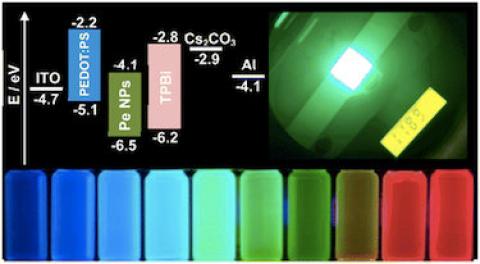Researchers at Nanyang Technological University in Singapore have fabricated high-performance green light-emitting diodes based on colloidal organometal perovskite nanoparticles. The devices have a maximum luminous efficiency of 11.49 cd/A, a power efficiency of 7.84 lm/W and an external quantum efficiency of 3.8%. This value is said to be about 3.5 times higher than that of the best colloidal perovskite quantum-dot-based LEDs previously made.

The team developed a simple way to make a series of colloidal (CH3NH3)PbX3 nanoparticles with an amorphous structure that can be tuned to emit light in the ultraviolet to near-infrared range. They studied the photoluminescence properties of the nanoparticles and found that the PLQE of the perovskite NP film is much higher than that of the bulk film. They then made the highly efficient green LED.
One of the main good properties of perovskite nanoparticles is their high quantum yield, reaching 77%. According to the researchers 'previous research also reported on the high quantum yield of as-synthesized perovskites, but these could not be separated easily from the solution in which they were produced so they were not suitable for making LED devices. Our perovskite nanoparticles can be easily separated from their processing solution by centrifuging and dispersing them into a colloid.'
The nanoparticles could be not only be used to make LEDs, but also solar cells, nanolasers, optical waveguides and more.
The team says that it now plans to optimize the LEDs it has made to improve their external quantum efficiency and that it also wants to construct LED structures with inorganic charge transport layers to improve the stability of the these devices.

